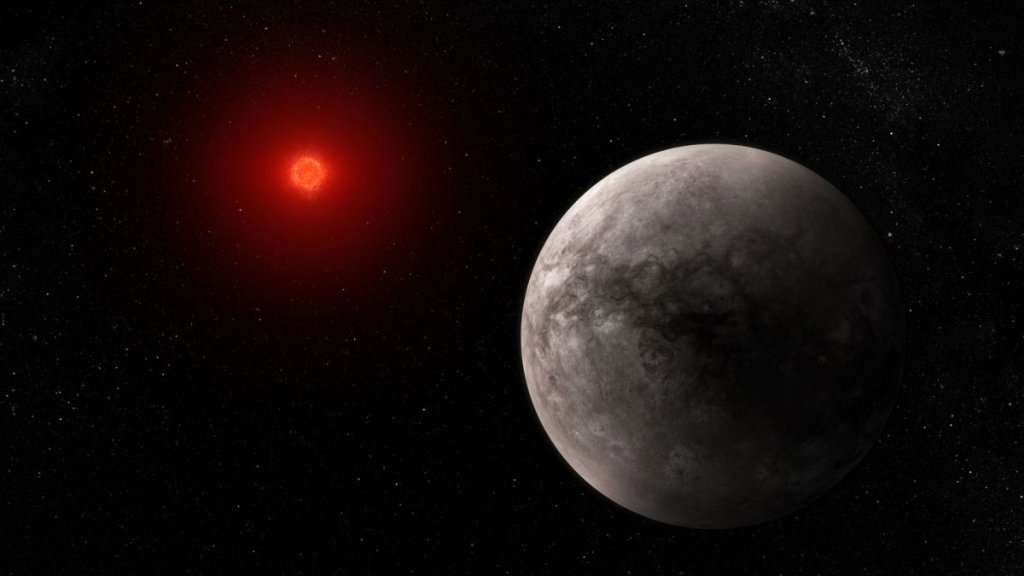New measurements by the James Webb Space Telescope found that a rocky exoplanet orbiting a star known as TRAPPIST-1 most likely has no atmosphere.
The finding squashes hopes that this intriguing world might host life. But don’t despair — there are six more Earth-like exoplanets in the TRAPPIST-1 star system, and now that Webb has proven its ability to study them, we can hope for some more exciting news in the not so distant future.
Astronomers used the James Webb Space Telescope‘s Mid-Infrared Instrument (MIRI) to measure the temperature of the planet TRAPPIST-1b. Out of the seven planets that make up the TRAPPIST-1 star system, this planet orbits the closest to the parent star and is about 1.4 times as large as Earth.
Related: Webb meets the 7 intriguing exoplanets of TRAPPIST-1
The measurement, which according to the European Space Agency (opens in new tab) (ESA) represents Webb’s first detection of “any form of light” emitted by a rocky exoplanet, revealed that the planet’s daytime temperature was a scorching 446 degrees Fahrenheit (230 degrees Celsius). Astronomers think that’s too high for the planet to have an atmosphere.
Thomas Greene, an astrophysicist in the Space Science and Astrobiology Division at NASA’s Ames Research Center in California who led the observations, told Space.com in an email that he had hoped for a different result.
“Some theory groups predicted that the planet would have a dense atmosphere, while others thought it might not,” Greene said. “I was more disappointed than surprised to see it had no atmosphere.”
The distance between TRAPPIST-1b and its star is only about one hundredth of the sun-Earth distance. That’s 40 times closer than the distance between the sun and the solar system‘s innermost planet Mercury.
Although the star at the center of the TRAPPIST-1 system is much dimmer than our sun, the planet still receives about four times as much starlight as Earth receives from the sun. Astronomers therefore didn’t expect this planet to be habitable prior to ruling out the presence of an atmosphere. The observation, however, is still a breakthrough, as it shows that Webb can directly gather information about such distant Earth-like worlds.
In the TRAPPIST-1 system, there are at least three planets — TRAPPIST-1e, 1f and 1g — that have conditions for the existence of liquid water on their surfaces and therefore might host life.
The TRAPPIST-1 system is a hugely popular target for exoplanet research and the best explored planetary system other than our own solar system, according to NASA (opens in new tab). Located some 40 light-years away from the sun, the star at the center of the TRAPPIST-1 system is a so-called M dwarf. Sometimes also referred to as red dwarfs, these stars are the smallest known type of stars capable of burning hydrogen in their cores. They range in size from 0.08 to 0.6 times the size of the sun and are the most numerous type of star in our galaxy, the Milky Way.
“There are about ten times as many M stars like TRAPPIST-1 than G stars like the sun,” Greene wrote. “M stars are also about twice as likely to have rocky, Earth-sized planets. Therefore about 95% of the Earth-sized rocky planets in the Milky Way will have stars like TRAPPIST-1 and not like the sun.”
For this reason, the TRAPPIST-1 star system is an important testbed that could help astronomers better understand where best conditions for life exist.
Previous observations with the Hubble Space Telescope and the now retired Spitzer Space Telescope found no traces of atmospheres on any of the TRAPPIST-1 planets. However, Greene said, a possibility still exists that a very thin atmosphere surrounds TRAPPIST-1b, one that might be completely different from the atmospheres shrouding planets in the solar system.
“We have some follow-up observations scheduled in June at another wavelength and have proposed observing a bigger part of the planet’s orbit to look into and maybe rule out some other types of atmospheres,” Greene said.
The study (opens in new tab) was published in the journal Nature on Monday, March 27.
Follow Tereza Pultarova on Twitter @TerezaPultarova (opens in new tab). Follow us on Twitter @Spacedotcom (opens in new tab) and on Facebook (opens in new tab).

